Business and Business Environment Report
VerifiedAdded on 2020/01/07
|21
|5394
|6350
Report
AI Summary
This report analyzes the business environment of Tesco and Iceland Ltd., two supermarket chains. It uses PESTEL analysis to examine the political, economic, social, technological, environmental, and legal factors impacting these businesses. The report also conducts internal and external analyses to identify strengths and weaknesses, linking them to macro factors. A SWOT analysis is performed, and the impact of PESTEL analysis on Tesco's decision-making is discussed. The report concludes by summarizing the size, scope, and structure of both companies and the various approaches used to identify their strengths and weaknesses. The report includes a table of contents and a comprehensive list of references.
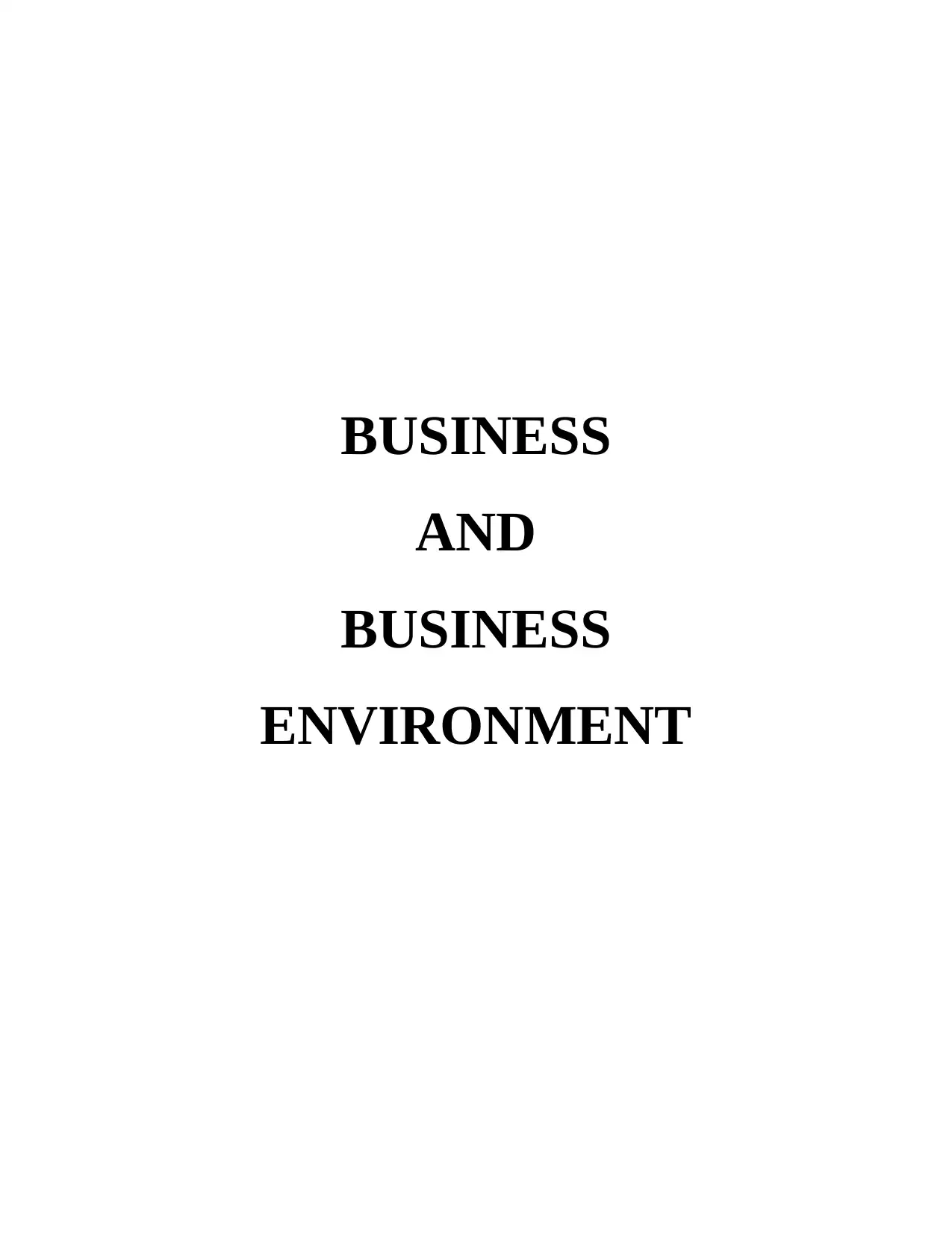
BUSINESS
AND
BUSINESS
ENVIRONMENT
AND
BUSINESS
ENVIRONMENT
Paraphrase This Document
Need a fresh take? Get an instant paraphrase of this document with our AI Paraphraser
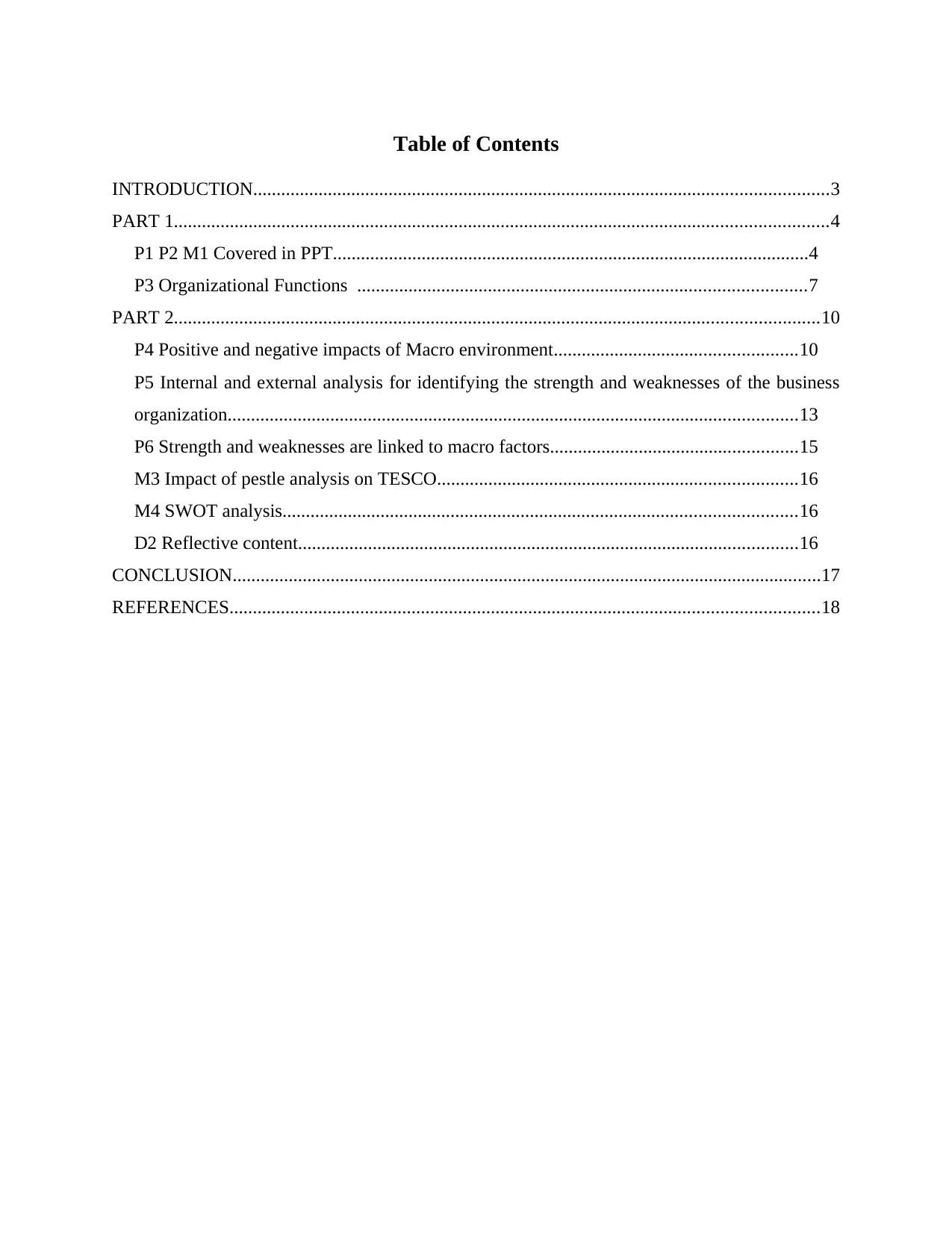
Table of Contents
INTRODUCTION...........................................................................................................................3
PART 1............................................................................................................................................4
P1 P2 M1 Covered in PPT......................................................................................................4
P3 Organizational Functions ................................................................................................7
PART 2..........................................................................................................................................10
P4 Positive and negative impacts of Macro environment....................................................10
P5 Internal and external analysis for identifying the strength and weaknesses of the business
organization..........................................................................................................................13
P6 Strength and weaknesses are linked to macro factors.....................................................15
M3 Impact of pestle analysis on TESCO.............................................................................16
M4 SWOT analysis..............................................................................................................16
D2 Reflective content...........................................................................................................16
CONCLUSION..............................................................................................................................17
REFERENCES..............................................................................................................................18
INTRODUCTION...........................................................................................................................3
PART 1............................................................................................................................................4
P1 P2 M1 Covered in PPT......................................................................................................4
P3 Organizational Functions ................................................................................................7
PART 2..........................................................................................................................................10
P4 Positive and negative impacts of Macro environment....................................................10
P5 Internal and external analysis for identifying the strength and weaknesses of the business
organization..........................................................................................................................13
P6 Strength and weaknesses are linked to macro factors.....................................................15
M3 Impact of pestle analysis on TESCO.............................................................................16
M4 SWOT analysis..............................................................................................................16
D2 Reflective content...........................................................................................................16
CONCLUSION..............................................................................................................................17
REFERENCES..............................................................................................................................18
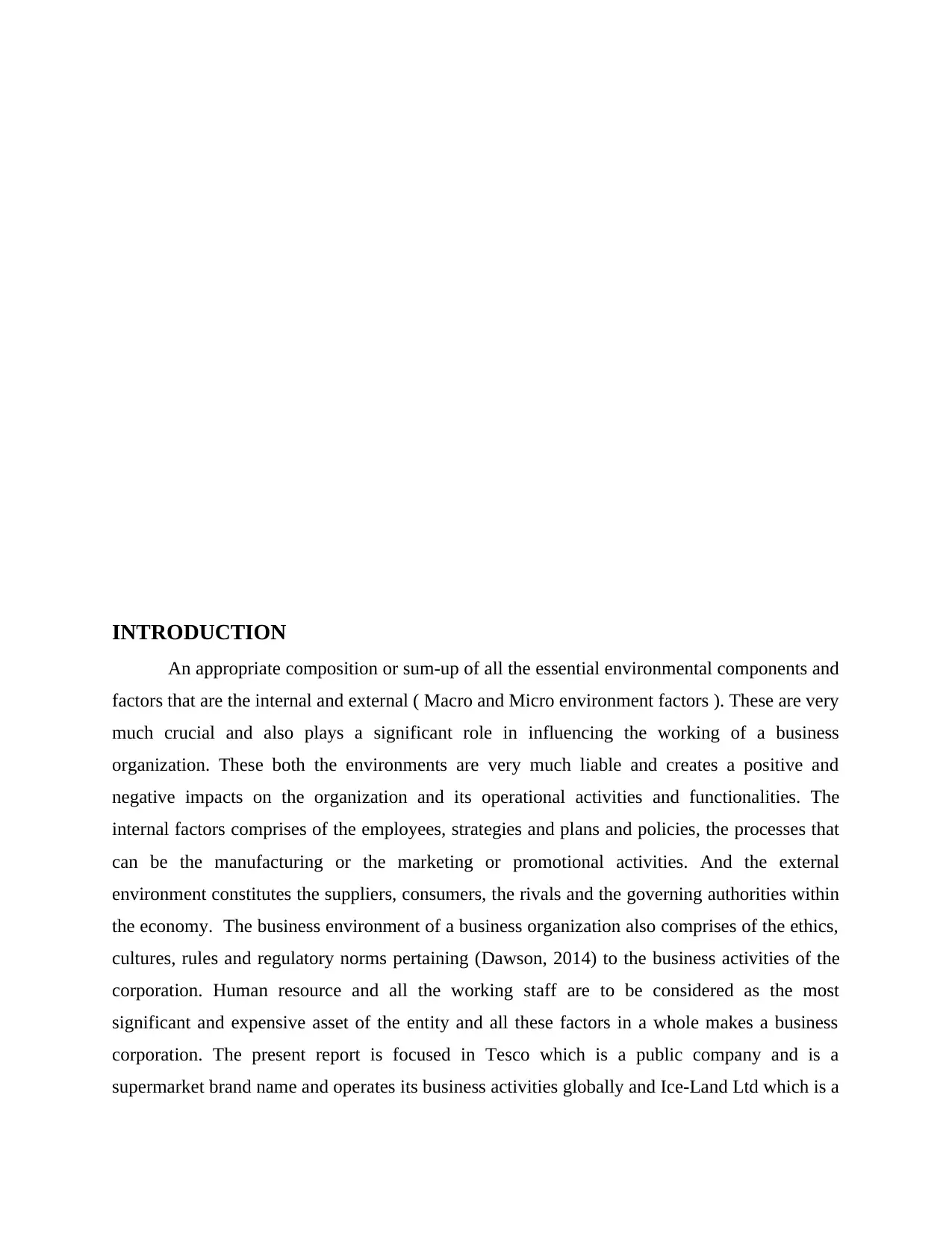
INTRODUCTION
An appropriate composition or sum-up of all the essential environmental components and
factors that are the internal and external ( Macro and Micro environment factors ). These are very
much crucial and also plays a significant role in influencing the working of a business
organization. These both the environments are very much liable and creates a positive and
negative impacts on the organization and its operational activities and functionalities. The
internal factors comprises of the employees, strategies and plans and policies, the processes that
can be the manufacturing or the marketing or promotional activities. And the external
environment constitutes the suppliers, consumers, the rivals and the governing authorities within
the economy. The business environment of a business organization also comprises of the ethics,
cultures, rules and regulatory norms pertaining (Dawson, 2014) to the business activities of the
corporation. Human resource and all the working staff are to be considered as the most
significant and expensive asset of the entity and all these factors in a whole makes a business
corporation. The present report is focused in Tesco which is a public company and is a
supermarket brand name and operates its business activities globally and Ice-Land Ltd which is a
An appropriate composition or sum-up of all the essential environmental components and
factors that are the internal and external ( Macro and Micro environment factors ). These are very
much crucial and also plays a significant role in influencing the working of a business
organization. These both the environments are very much liable and creates a positive and
negative impacts on the organization and its operational activities and functionalities. The
internal factors comprises of the employees, strategies and plans and policies, the processes that
can be the manufacturing or the marketing or promotional activities. And the external
environment constitutes the suppliers, consumers, the rivals and the governing authorities within
the economy. The business environment of a business organization also comprises of the ethics,
cultures, rules and regulatory norms pertaining (Dawson, 2014) to the business activities of the
corporation. Human resource and all the working staff are to be considered as the most
significant and expensive asset of the entity and all these factors in a whole makes a business
corporation. The present report is focused in Tesco which is a public company and is a
supermarket brand name and operates its business activities globally and Ice-Land Ltd which is a
⊘ This is a preview!⊘
Do you want full access?
Subscribe today to unlock all pages.

Trusted by 1+ million students worldwide
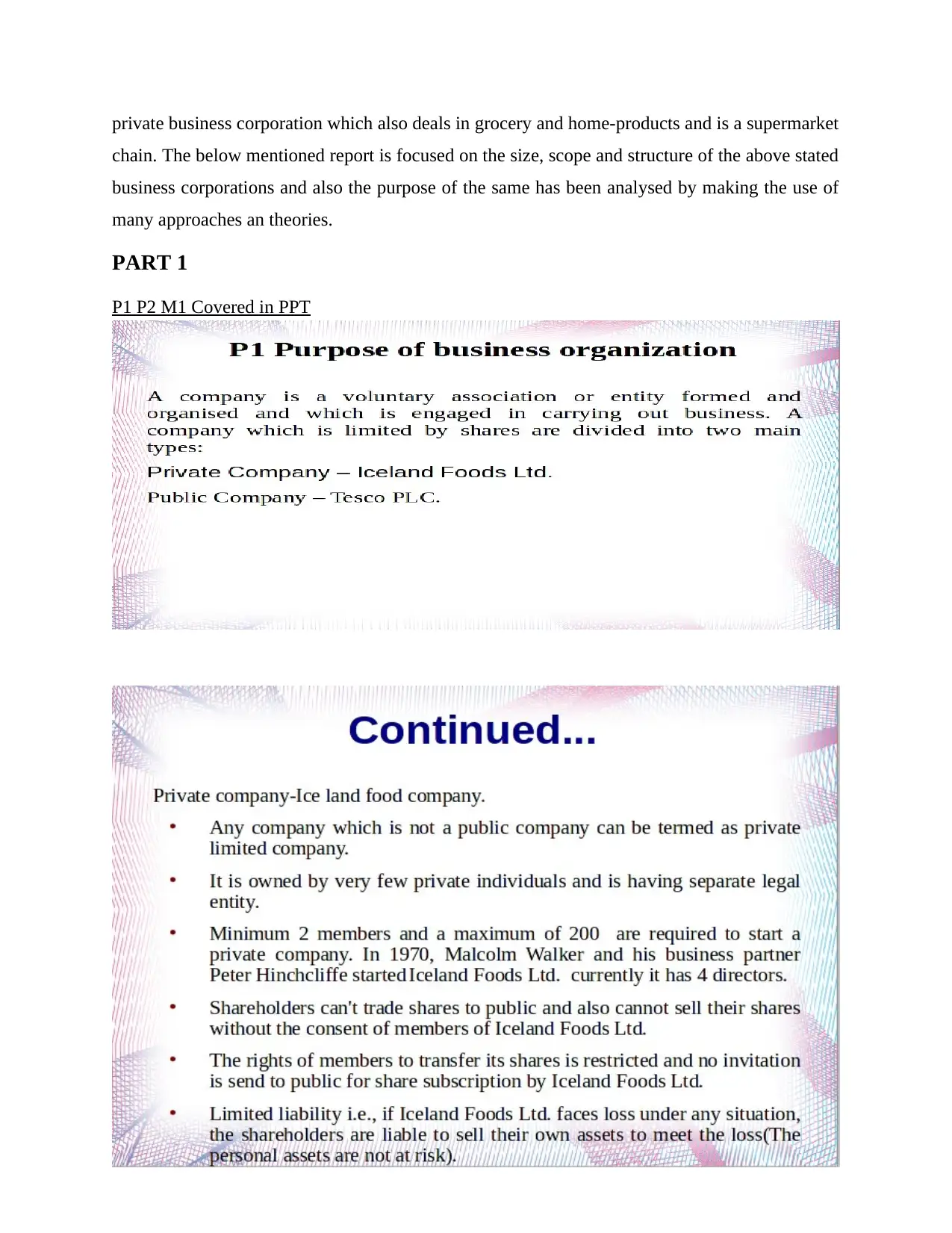
private business corporation which also deals in grocery and home-products and is a supermarket
chain. The below mentioned report is focused on the size, scope and structure of the above stated
business corporations and also the purpose of the same has been analysed by making the use of
many approaches an theories.
PART 1
P1 P2 M1 Covered in PPT
chain. The below mentioned report is focused on the size, scope and structure of the above stated
business corporations and also the purpose of the same has been analysed by making the use of
many approaches an theories.
PART 1
P1 P2 M1 Covered in PPT
Paraphrase This Document
Need a fresh take? Get an instant paraphrase of this document with our AI Paraphraser
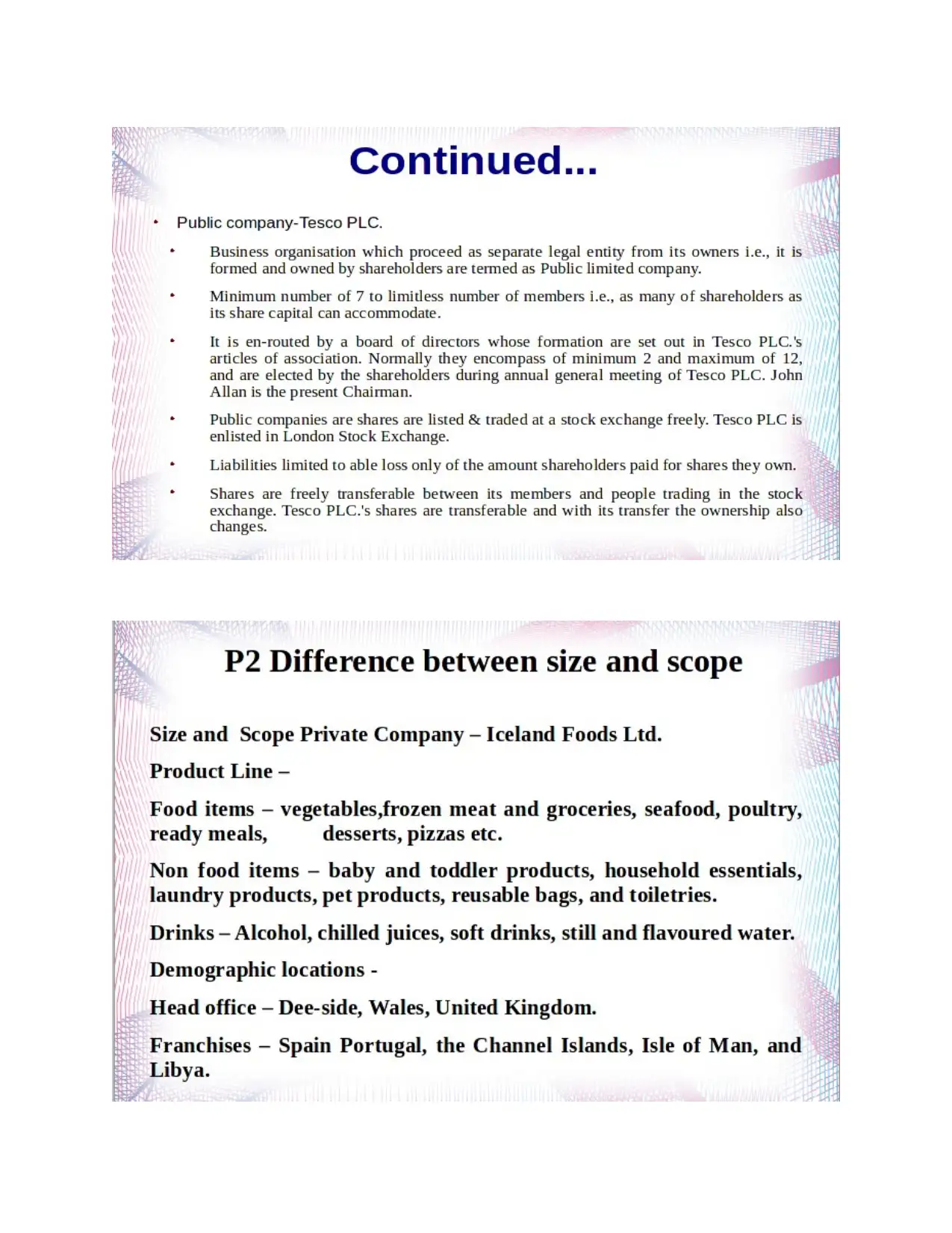
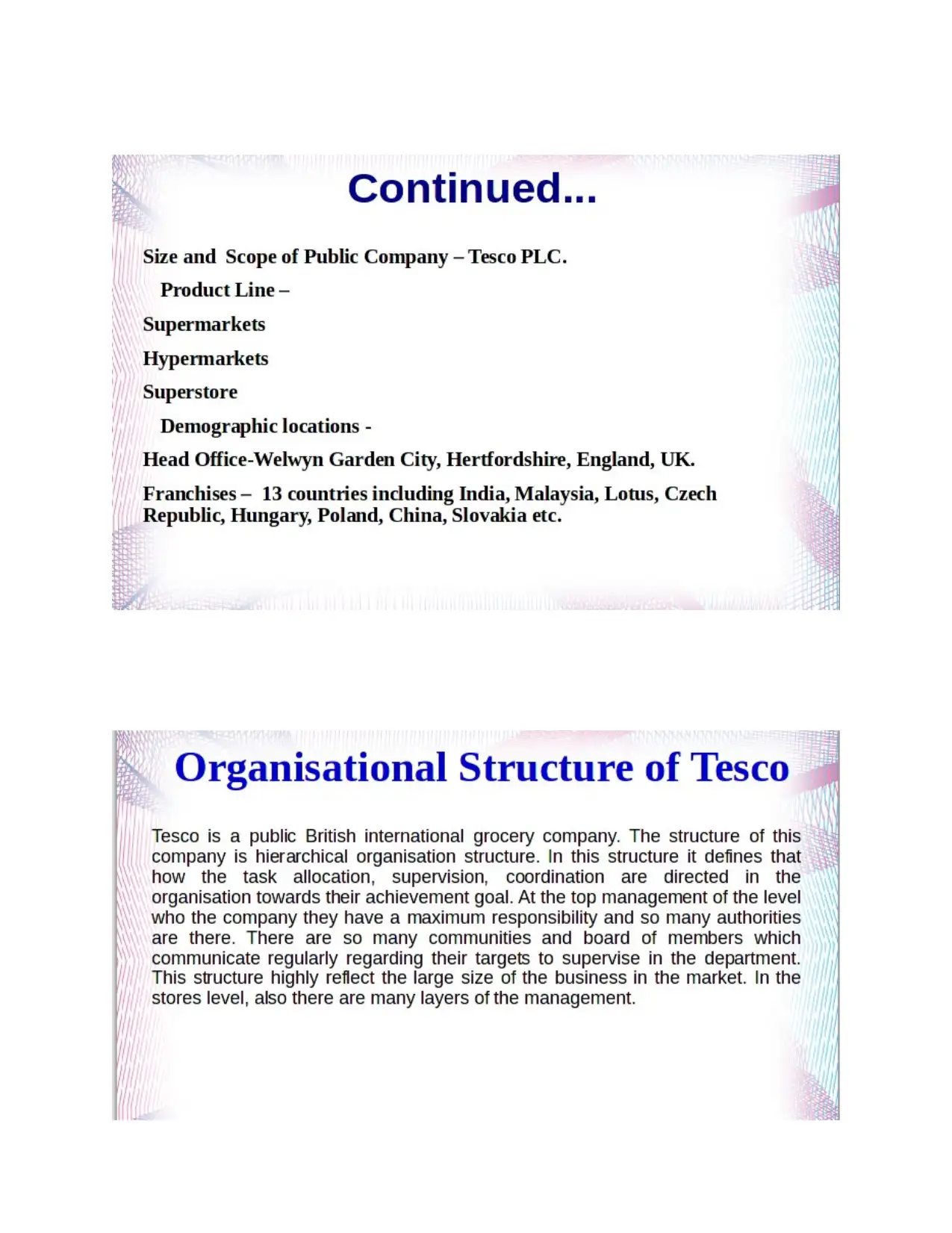
⊘ This is a preview!⊘
Do you want full access?
Subscribe today to unlock all pages.

Trusted by 1+ million students worldwide
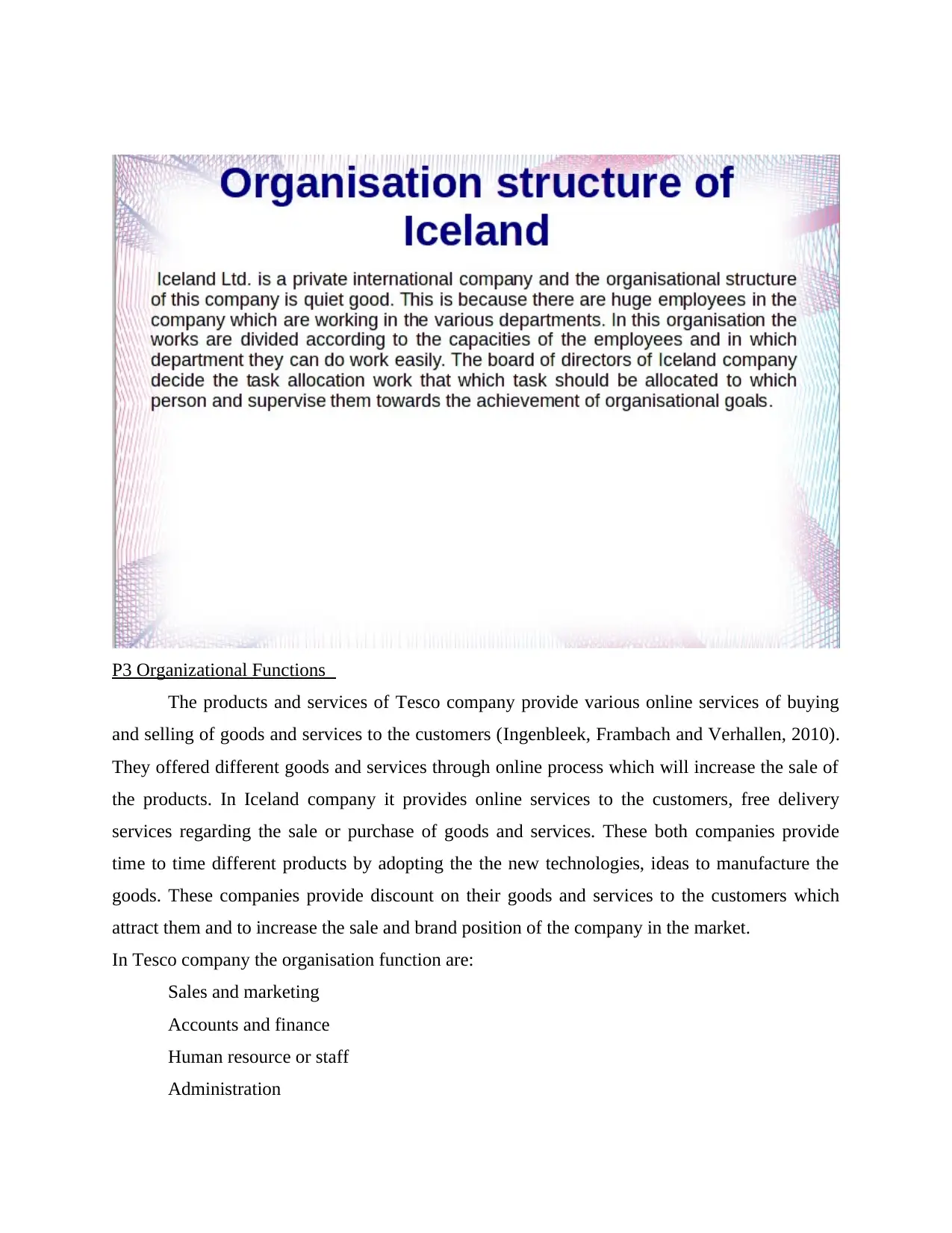
P3 Organizational Functions
The products and services of Tesco company provide various online services of buying
and selling of goods and services to the customers (Ingenbleek, Frambach and Verhallen, 2010).
They offered different goods and services through online process which will increase the sale of
the products. In Iceland company it provides online services to the customers, free delivery
services regarding the sale or purchase of goods and services. These both companies provide
time to time different products by adopting the the new technologies, ideas to manufacture the
goods. These companies provide discount on their goods and services to the customers which
attract them and to increase the sale and brand position of the company in the market.
In Tesco company the organisation function are:
Sales and marketing
Accounts and finance
Human resource or staff
Administration
The products and services of Tesco company provide various online services of buying
and selling of goods and services to the customers (Ingenbleek, Frambach and Verhallen, 2010).
They offered different goods and services through online process which will increase the sale of
the products. In Iceland company it provides online services to the customers, free delivery
services regarding the sale or purchase of goods and services. These both companies provide
time to time different products by adopting the the new technologies, ideas to manufacture the
goods. These companies provide discount on their goods and services to the customers which
attract them and to increase the sale and brand position of the company in the market.
In Tesco company the organisation function are:
Sales and marketing
Accounts and finance
Human resource or staff
Administration
Paraphrase This Document
Need a fresh take? Get an instant paraphrase of this document with our AI Paraphraser
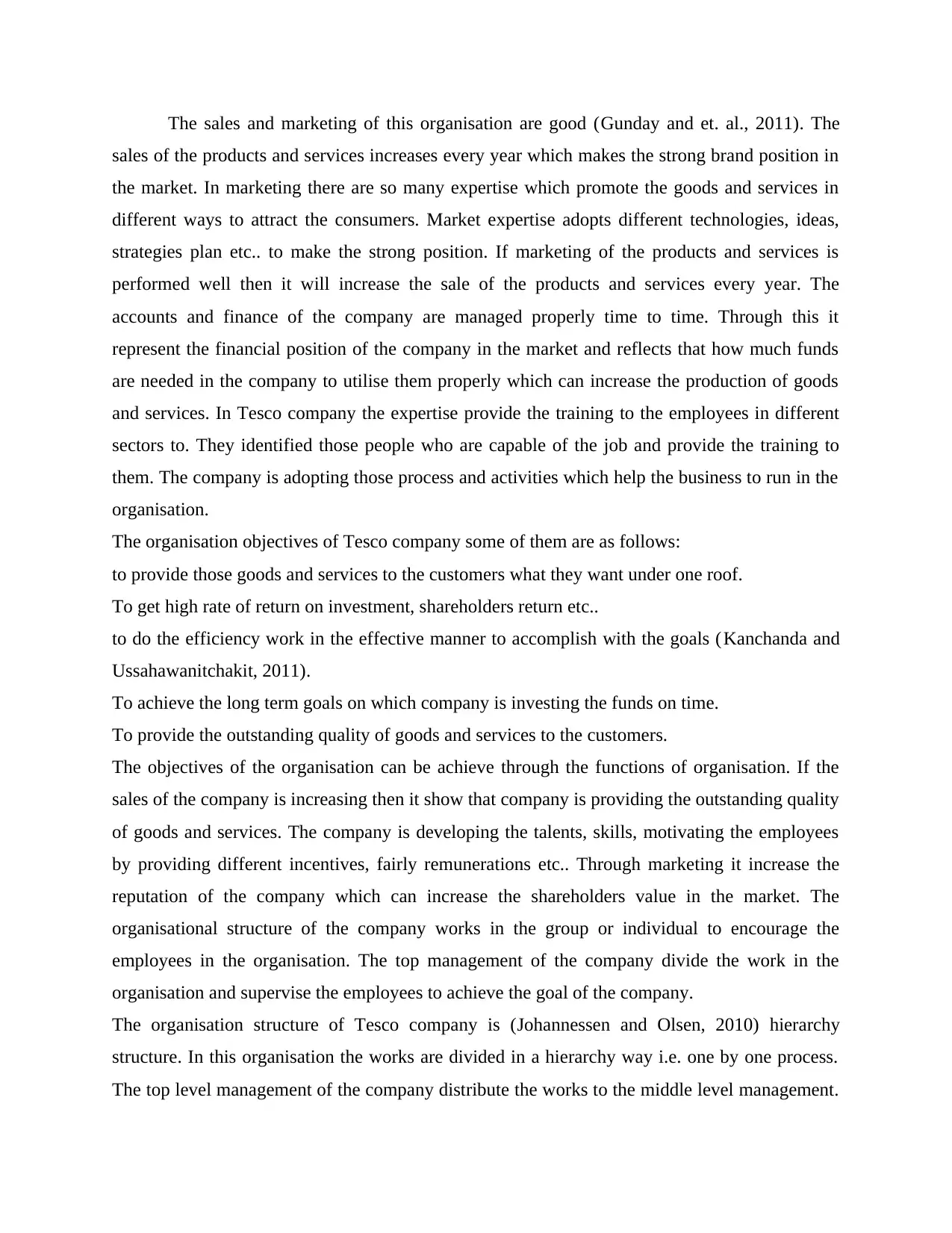
The sales and marketing of this organisation are good (Gunday and et. al., 2011). The
sales of the products and services increases every year which makes the strong brand position in
the market. In marketing there are so many expertise which promote the goods and services in
different ways to attract the consumers. Market expertise adopts different technologies, ideas,
strategies plan etc.. to make the strong position. If marketing of the products and services is
performed well then it will increase the sale of the products and services every year. The
accounts and finance of the company are managed properly time to time. Through this it
represent the financial position of the company in the market and reflects that how much funds
are needed in the company to utilise them properly which can increase the production of goods
and services. In Tesco company the expertise provide the training to the employees in different
sectors to. They identified those people who are capable of the job and provide the training to
them. The company is adopting those process and activities which help the business to run in the
organisation.
The organisation objectives of Tesco company some of them are as follows:
to provide those goods and services to the customers what they want under one roof.
To get high rate of return on investment, shareholders return etc..
to do the efficiency work in the effective manner to accomplish with the goals (Kanchanda and
Ussahawanitchakit, 2011).
To achieve the long term goals on which company is investing the funds on time.
To provide the outstanding quality of goods and services to the customers.
The objectives of the organisation can be achieve through the functions of organisation. If the
sales of the company is increasing then it show that company is providing the outstanding quality
of goods and services. The company is developing the talents, skills, motivating the employees
by providing different incentives, fairly remunerations etc.. Through marketing it increase the
reputation of the company which can increase the shareholders value in the market. The
organisational structure of the company works in the group or individual to encourage the
employees in the organisation. The top management of the company divide the work in the
organisation and supervise the employees to achieve the goal of the company.
The organisation structure of Tesco company is (Johannessen and Olsen, 2010) hierarchy
structure. In this organisation the works are divided in a hierarchy way i.e. one by one process.
The top level management of the company distribute the works to the middle level management.
sales of the products and services increases every year which makes the strong brand position in
the market. In marketing there are so many expertise which promote the goods and services in
different ways to attract the consumers. Market expertise adopts different technologies, ideas,
strategies plan etc.. to make the strong position. If marketing of the products and services is
performed well then it will increase the sale of the products and services every year. The
accounts and finance of the company are managed properly time to time. Through this it
represent the financial position of the company in the market and reflects that how much funds
are needed in the company to utilise them properly which can increase the production of goods
and services. In Tesco company the expertise provide the training to the employees in different
sectors to. They identified those people who are capable of the job and provide the training to
them. The company is adopting those process and activities which help the business to run in the
organisation.
The organisation objectives of Tesco company some of them are as follows:
to provide those goods and services to the customers what they want under one roof.
To get high rate of return on investment, shareholders return etc..
to do the efficiency work in the effective manner to accomplish with the goals (Kanchanda and
Ussahawanitchakit, 2011).
To achieve the long term goals on which company is investing the funds on time.
To provide the outstanding quality of goods and services to the customers.
The objectives of the organisation can be achieve through the functions of organisation. If the
sales of the company is increasing then it show that company is providing the outstanding quality
of goods and services. The company is developing the talents, skills, motivating the employees
by providing different incentives, fairly remunerations etc.. Through marketing it increase the
reputation of the company which can increase the shareholders value in the market. The
organisational structure of the company works in the group or individual to encourage the
employees in the organisation. The top management of the company divide the work in the
organisation and supervise the employees to achieve the goal of the company.
The organisation structure of Tesco company is (Johannessen and Olsen, 2010) hierarchy
structure. In this organisation the works are divided in a hierarchy way i.e. one by one process.
The top level management of the company distribute the works to the middle level management.
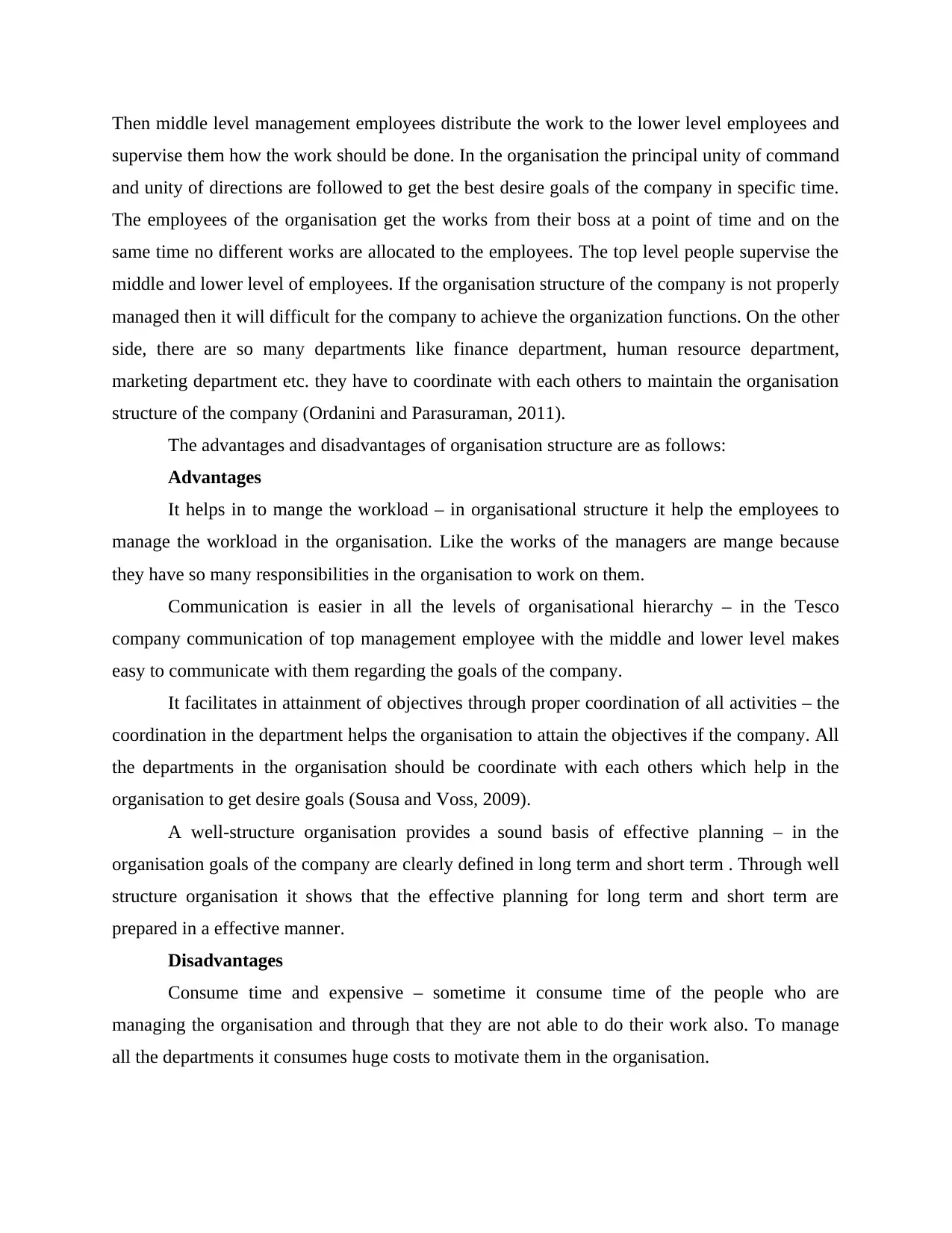
Then middle level management employees distribute the work to the lower level employees and
supervise them how the work should be done. In the organisation the principal unity of command
and unity of directions are followed to get the best desire goals of the company in specific time.
The employees of the organisation get the works from their boss at a point of time and on the
same time no different works are allocated to the employees. The top level people supervise the
middle and lower level of employees. If the organisation structure of the company is not properly
managed then it will difficult for the company to achieve the organization functions. On the other
side, there are so many departments like finance department, human resource department,
marketing department etc. they have to coordinate with each others to maintain the organisation
structure of the company (Ordanini and Parasuraman, 2011).
The advantages and disadvantages of organisation structure are as follows:
Advantages
It helps in to mange the workload – in organisational structure it help the employees to
manage the workload in the organisation. Like the works of the managers are mange because
they have so many responsibilities in the organisation to work on them.
Communication is easier in all the levels of organisational hierarchy – in the Tesco
company communication of top management employee with the middle and lower level makes
easy to communicate with them regarding the goals of the company.
It facilitates in attainment of objectives through proper coordination of all activities – the
coordination in the department helps the organisation to attain the objectives if the company. All
the departments in the organisation should be coordinate with each others which help in the
organisation to get desire goals (Sousa and Voss, 2009).
A well-structure organisation provides a sound basis of effective planning – in the
organisation goals of the company are clearly defined in long term and short term . Through well
structure organisation it shows that the effective planning for long term and short term are
prepared in a effective manner.
Disadvantages
Consume time and expensive – sometime it consume time of the people who are
managing the organisation and through that they are not able to do their work also. To manage
all the departments it consumes huge costs to motivate them in the organisation.
supervise them how the work should be done. In the organisation the principal unity of command
and unity of directions are followed to get the best desire goals of the company in specific time.
The employees of the organisation get the works from their boss at a point of time and on the
same time no different works are allocated to the employees. The top level people supervise the
middle and lower level of employees. If the organisation structure of the company is not properly
managed then it will difficult for the company to achieve the organization functions. On the other
side, there are so many departments like finance department, human resource department,
marketing department etc. they have to coordinate with each others to maintain the organisation
structure of the company (Ordanini and Parasuraman, 2011).
The advantages and disadvantages of organisation structure are as follows:
Advantages
It helps in to mange the workload – in organisational structure it help the employees to
manage the workload in the organisation. Like the works of the managers are mange because
they have so many responsibilities in the organisation to work on them.
Communication is easier in all the levels of organisational hierarchy – in the Tesco
company communication of top management employee with the middle and lower level makes
easy to communicate with them regarding the goals of the company.
It facilitates in attainment of objectives through proper coordination of all activities – the
coordination in the department helps the organisation to attain the objectives if the company. All
the departments in the organisation should be coordinate with each others which help in the
organisation to get desire goals (Sousa and Voss, 2009).
A well-structure organisation provides a sound basis of effective planning – in the
organisation goals of the company are clearly defined in long term and short term . Through well
structure organisation it shows that the effective planning for long term and short term are
prepared in a effective manner.
Disadvantages
Consume time and expensive – sometime it consume time of the people who are
managing the organisation and through that they are not able to do their work also. To manage
all the departments it consumes huge costs to motivate them in the organisation.
⊘ This is a preview!⊘
Do you want full access?
Subscribe today to unlock all pages.

Trusted by 1+ million students worldwide
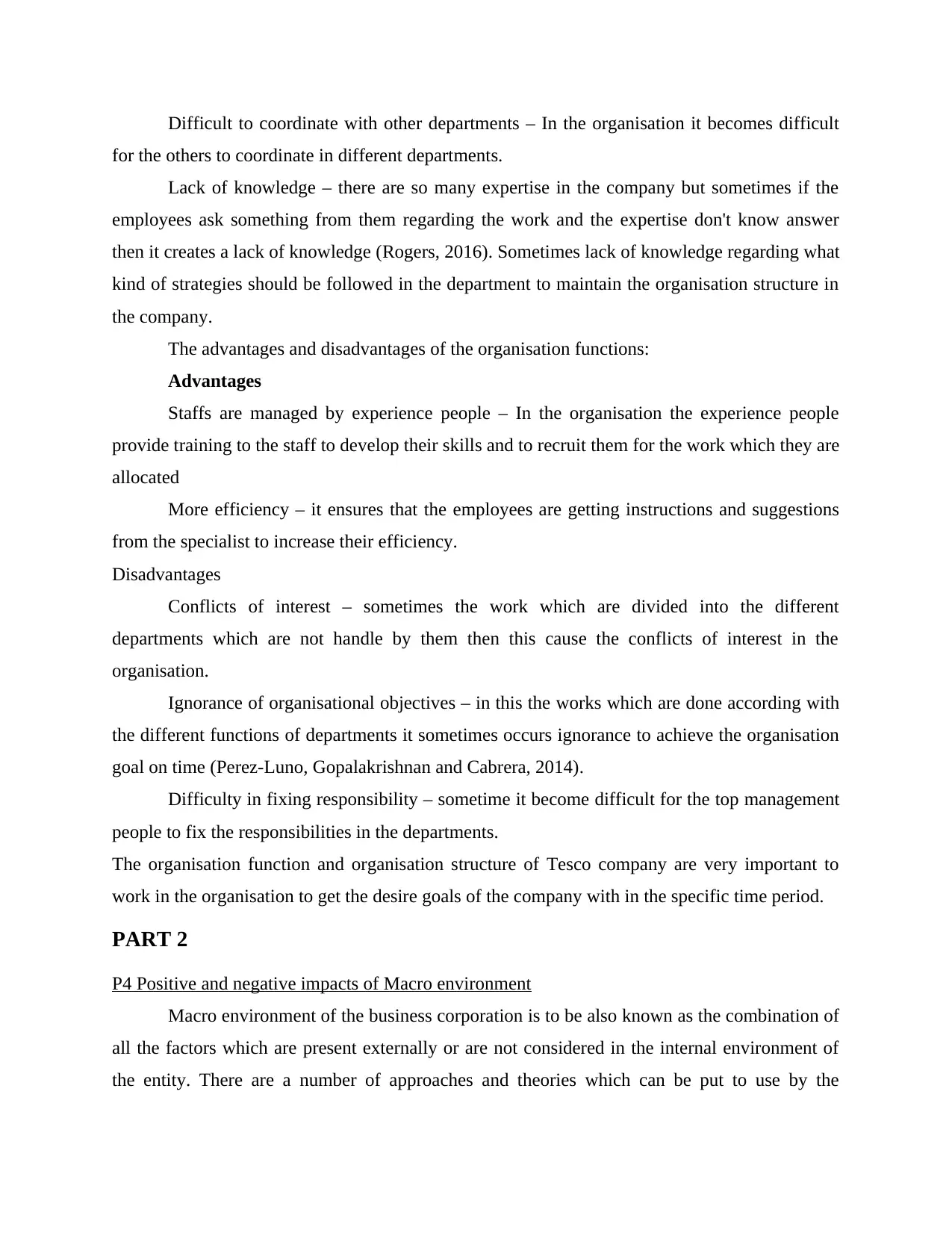
Difficult to coordinate with other departments – In the organisation it becomes difficult
for the others to coordinate in different departments.
Lack of knowledge – there are so many expertise in the company but sometimes if the
employees ask something from them regarding the work and the expertise don't know answer
then it creates a lack of knowledge (Rogers, 2016). Sometimes lack of knowledge regarding what
kind of strategies should be followed in the department to maintain the organisation structure in
the company.
The advantages and disadvantages of the organisation functions:
Advantages
Staffs are managed by experience people – In the organisation the experience people
provide training to the staff to develop their skills and to recruit them for the work which they are
allocated
More efficiency – it ensures that the employees are getting instructions and suggestions
from the specialist to increase their efficiency.
Disadvantages
Conflicts of interest – sometimes the work which are divided into the different
departments which are not handle by them then this cause the conflicts of interest in the
organisation.
Ignorance of organisational objectives – in this the works which are done according with
the different functions of departments it sometimes occurs ignorance to achieve the organisation
goal on time (Perez-Luno, Gopalakrishnan and Cabrera, 2014).
Difficulty in fixing responsibility – sometime it become difficult for the top management
people to fix the responsibilities in the departments.
The organisation function and organisation structure of Tesco company are very important to
work in the organisation to get the desire goals of the company with in the specific time period.
PART 2
P4 Positive and negative impacts of Macro environment
Macro environment of the business corporation is to be also known as the combination of
all the factors which are present externally or are not considered in the internal environment of
the entity. There are a number of approaches and theories which can be put to use by the
for the others to coordinate in different departments.
Lack of knowledge – there are so many expertise in the company but sometimes if the
employees ask something from them regarding the work and the expertise don't know answer
then it creates a lack of knowledge (Rogers, 2016). Sometimes lack of knowledge regarding what
kind of strategies should be followed in the department to maintain the organisation structure in
the company.
The advantages and disadvantages of the organisation functions:
Advantages
Staffs are managed by experience people – In the organisation the experience people
provide training to the staff to develop their skills and to recruit them for the work which they are
allocated
More efficiency – it ensures that the employees are getting instructions and suggestions
from the specialist to increase their efficiency.
Disadvantages
Conflicts of interest – sometimes the work which are divided into the different
departments which are not handle by them then this cause the conflicts of interest in the
organisation.
Ignorance of organisational objectives – in this the works which are done according with
the different functions of departments it sometimes occurs ignorance to achieve the organisation
goal on time (Perez-Luno, Gopalakrishnan and Cabrera, 2014).
Difficulty in fixing responsibility – sometime it become difficult for the top management
people to fix the responsibilities in the departments.
The organisation function and organisation structure of Tesco company are very important to
work in the organisation to get the desire goals of the company with in the specific time period.
PART 2
P4 Positive and negative impacts of Macro environment
Macro environment of the business corporation is to be also known as the combination of
all the factors which are present externally or are not considered in the internal environment of
the entity. There are a number of approaches and theories which can be put to use by the
Paraphrase This Document
Need a fresh take? Get an instant paraphrase of this document with our AI Paraphraser
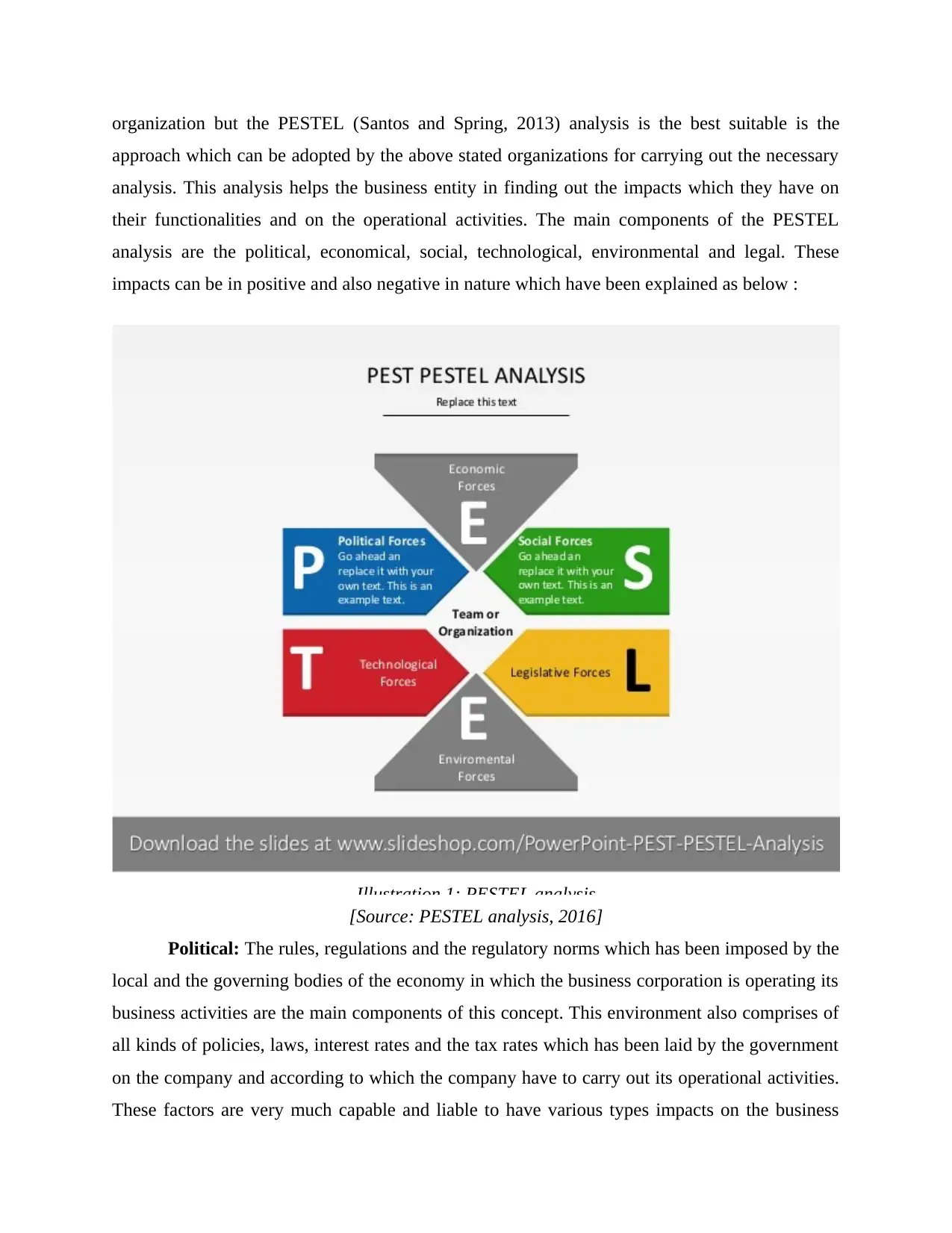
organization but the PESTEL (Santos and Spring, 2013) analysis is the best suitable is the
approach which can be adopted by the above stated organizations for carrying out the necessary
analysis. This analysis helps the business entity in finding out the impacts which they have on
their functionalities and on the operational activities. The main components of the PESTEL
analysis are the political, economical, social, technological, environmental and legal. These
impacts can be in positive and also negative in nature which have been explained as below :
[Source: PESTEL analysis, 2016]
Political: The rules, regulations and the regulatory norms which has been imposed by the
local and the governing bodies of the economy in which the business corporation is operating its
business activities are the main components of this concept. This environment also comprises of
all kinds of policies, laws, interest rates and the tax rates which has been laid by the government
on the company and according to which the company have to carry out its operational activities.
These factors are very much capable and liable to have various types impacts on the business
Illustration 1: PESTEL analysis
approach which can be adopted by the above stated organizations for carrying out the necessary
analysis. This analysis helps the business entity in finding out the impacts which they have on
their functionalities and on the operational activities. The main components of the PESTEL
analysis are the political, economical, social, technological, environmental and legal. These
impacts can be in positive and also negative in nature which have been explained as below :
[Source: PESTEL analysis, 2016]
Political: The rules, regulations and the regulatory norms which has been imposed by the
local and the governing bodies of the economy in which the business corporation is operating its
business activities are the main components of this concept. This environment also comprises of
all kinds of policies, laws, interest rates and the tax rates which has been laid by the government
on the company and according to which the company have to carry out its operational activities.
These factors are very much capable and liable to have various types impacts on the business
Illustration 1: PESTEL analysis
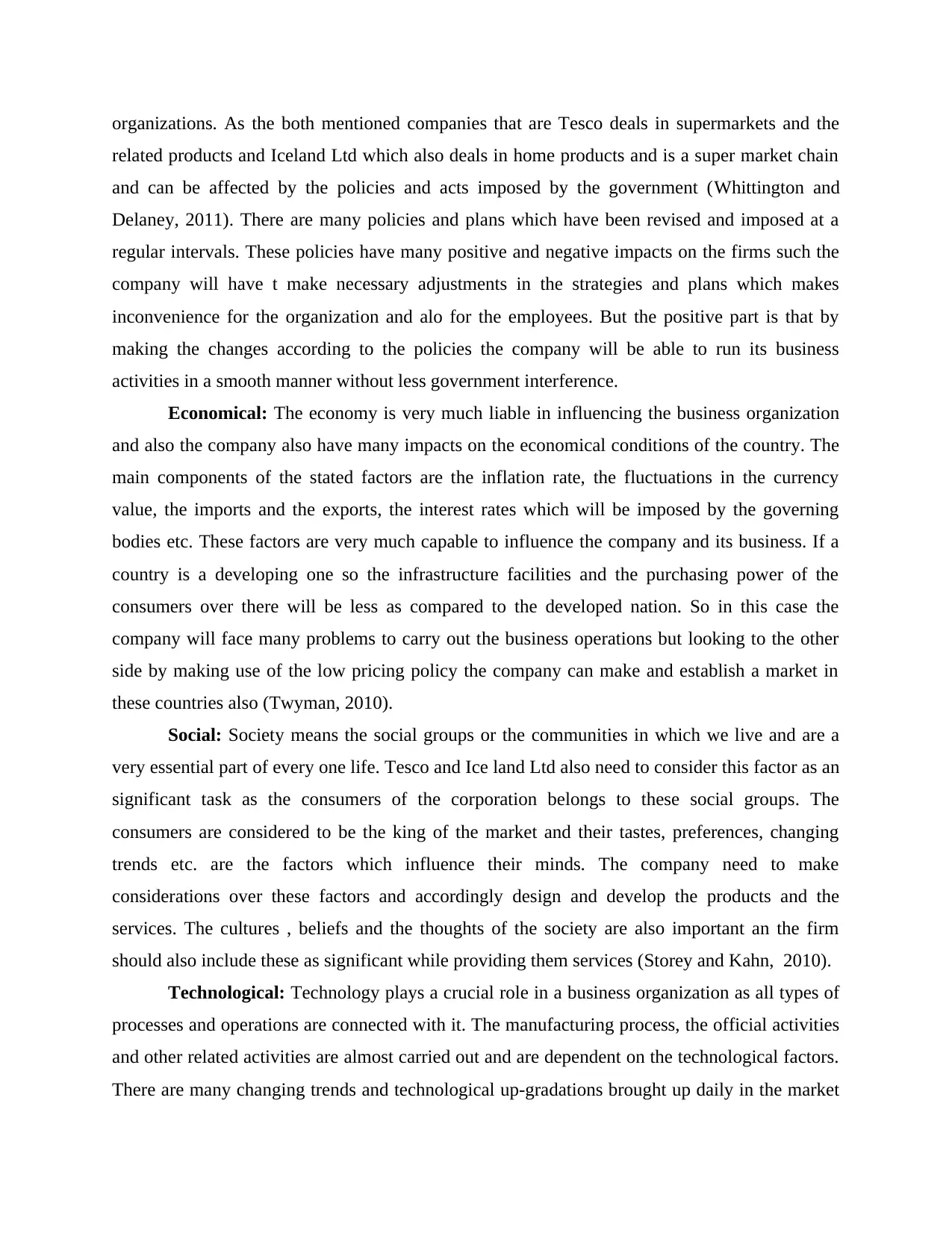
organizations. As the both mentioned companies that are Tesco deals in supermarkets and the
related products and Iceland Ltd which also deals in home products and is a super market chain
and can be affected by the policies and acts imposed by the government (Whittington and
Delaney, 2011). There are many policies and plans which have been revised and imposed at a
regular intervals. These policies have many positive and negative impacts on the firms such the
company will have t make necessary adjustments in the strategies and plans which makes
inconvenience for the organization and alo for the employees. But the positive part is that by
making the changes according to the policies the company will be able to run its business
activities in a smooth manner without less government interference.
Economical: The economy is very much liable in influencing the business organization
and also the company also have many impacts on the economical conditions of the country. The
main components of the stated factors are the inflation rate, the fluctuations in the currency
value, the imports and the exports, the interest rates which will be imposed by the governing
bodies etc. These factors are very much capable to influence the company and its business. If a
country is a developing one so the infrastructure facilities and the purchasing power of the
consumers over there will be less as compared to the developed nation. So in this case the
company will face many problems to carry out the business operations but looking to the other
side by making use of the low pricing policy the company can make and establish a market in
these countries also (Twyman, 2010).
Social: Society means the social groups or the communities in which we live and are a
very essential part of every one life. Tesco and Ice land Ltd also need to consider this factor as an
significant task as the consumers of the corporation belongs to these social groups. The
consumers are considered to be the king of the market and their tastes, preferences, changing
trends etc. are the factors which influence their minds. The company need to make
considerations over these factors and accordingly design and develop the products and the
services. The cultures , beliefs and the thoughts of the society are also important an the firm
should also include these as significant while providing them services (Storey and Kahn, 2010).
Technological: Technology plays a crucial role in a business organization as all types of
processes and operations are connected with it. The manufacturing process, the official activities
and other related activities are almost carried out and are dependent on the technological factors.
There are many changing trends and technological up-gradations brought up daily in the market
related products and Iceland Ltd which also deals in home products and is a super market chain
and can be affected by the policies and acts imposed by the government (Whittington and
Delaney, 2011). There are many policies and plans which have been revised and imposed at a
regular intervals. These policies have many positive and negative impacts on the firms such the
company will have t make necessary adjustments in the strategies and plans which makes
inconvenience for the organization and alo for the employees. But the positive part is that by
making the changes according to the policies the company will be able to run its business
activities in a smooth manner without less government interference.
Economical: The economy is very much liable in influencing the business organization
and also the company also have many impacts on the economical conditions of the country. The
main components of the stated factors are the inflation rate, the fluctuations in the currency
value, the imports and the exports, the interest rates which will be imposed by the governing
bodies etc. These factors are very much capable to influence the company and its business. If a
country is a developing one so the infrastructure facilities and the purchasing power of the
consumers over there will be less as compared to the developed nation. So in this case the
company will face many problems to carry out the business operations but looking to the other
side by making use of the low pricing policy the company can make and establish a market in
these countries also (Twyman, 2010).
Social: Society means the social groups or the communities in which we live and are a
very essential part of every one life. Tesco and Ice land Ltd also need to consider this factor as an
significant task as the consumers of the corporation belongs to these social groups. The
consumers are considered to be the king of the market and their tastes, preferences, changing
trends etc. are the factors which influence their minds. The company need to make
considerations over these factors and accordingly design and develop the products and the
services. The cultures , beliefs and the thoughts of the society are also important an the firm
should also include these as significant while providing them services (Storey and Kahn, 2010).
Technological: Technology plays a crucial role in a business organization as all types of
processes and operations are connected with it. The manufacturing process, the official activities
and other related activities are almost carried out and are dependent on the technological factors.
There are many changing trends and technological up-gradations brought up daily in the market
⊘ This is a preview!⊘
Do you want full access?
Subscribe today to unlock all pages.

Trusted by 1+ million students worldwide
1 out of 21
Related Documents
Your All-in-One AI-Powered Toolkit for Academic Success.
+13062052269
info@desklib.com
Available 24*7 on WhatsApp / Email
![[object Object]](/_next/static/media/star-bottom.7253800d.svg)
Unlock your academic potential
Copyright © 2020–2025 A2Z Services. All Rights Reserved. Developed and managed by ZUCOL.





